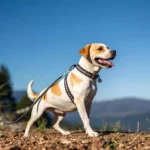
Introduction
Blindness in dogs can stem from various causes, including genetic factors, age-related conditions like cataracts and glaucoma, or injuries. Regardless of the reason, a blind dog often faces unique challenges that can affect its quality of life. Navigating the world without sight can be daunting, and it can lead to anxiety and confusion. Understanding how to support a blind dog is essential for any pet owner who wishes to enhance their furry companion’s comfort and safety.
Proper mobility aids, particularly harnesses, play a crucial role in promoting independence and ensuring the safety of blind dogs. A well-designed harness can provide better control during walks, allowing owners to guide their dogs while also offering comfort and security. This article aims to explore the best harnesses for blind dogs, covering their specific needs, key features to look for, and recommendations for top products.
Understanding the Needs of Blind Dogs
Behavioral Adjustments
Blind dogs often adapt to their environment using their other senses—scent, sound, and touch. They rely heavily on these sensory inputs to navigate their surroundings. For instance, dogs may use scent to identify familiar paths or sounds to locate their owners. However, this heightened reliance on non-visual cues can be challenging, as it makes them more vulnerable to accidents if they encounter unfamiliar environments.
Safety Considerations
Walking a blind dog without proper equipment poses several risks. Without clear guidance, a blind dog can easily bump into obstacles or stray into dangerous areas. A harness designed specifically for blind dogs offers a layer of protection by providing better handling and control. It helps prevent accidents and ensures that the dog feels secure while exploring its surroundings.
Key Features to Look for in a Harness for Blind Dogs
Comfort and Fit
When selecting a harness for a blind dog, comfort should be the top priority. A well-fitted harness should have adjustable straps and ample cushioning to prevent chafing and ensure ease of movement. Proper sizing is crucial; an ill-fitting harness can lead to discomfort and insecurity. Measure your dog’s girth and neck to find the ideal size.
Visibility and Identification
Visibility is critical for blind dogs. Look for harnesses made from reflective materials or bright colors to enhance visibility, especially during walks in low-light conditions. Additionally, having identification tags attached to the harness is essential in case the dog gets lost.
Control and Support
A harness should offer features that provide better control. Look for models with sturdy handles and multiple attachment points for leashes. These elements allow for greater support when guiding a blind dog through various terrains. A supportive harness can also help prevent injuries by distributing pressure evenly across the dog’s body.
Durability and Maintenance
Durability is another significant factor when choosing a harness. Opt for materials that withstand wear and tear, especially if your dog enjoys outdoor adventures. Furthermore, consider harnesses that are easy to clean and maintain, as this will keep your dog’s gear in good condition for years.
Top 5 Best Harnesses for Blind Dogs
Product Name: Ruffwear Front Range Harness
The Ruffwear Front Range Harness is a popular choice among pet owners for its combination of comfort and functionality. It features padded chest and belly panels for a secure fit, along with two leash attachment points for versatility. This harness also includes reflective trim for added visibility during nighttime walks.
Pros:
– Comfortable fit with padding
– Two leash attachment points
– Reflective materials for visibility
Cons:
– May be challenging to adjust for some users
– Higher price point compared to other options
User Ratings: 4.8/5
Product Name: PetSafe Easy Walk Harness
The PetSafe Easy Walk Harness is designed specifically to prevent pulling, making it a great option for dogs that may be anxious or easily startled. Its unique design allows for control without putting pressure on the dog’s neck. The harness is also easy to put on and adjust, ensuring a comfortable fit.
Pros:
– Reduces pulling behavior
– Easy to adjust and wear
– Distributes pressure evenly
Cons:
– Not suitable for very large or heavy dogs
– Some users report durability issues
User Ratings: 4.5/5
Product Name: Blue-9 Pet Products Balance Harness
The Blue-9 Pet Products Balance Harness is designed for ultimate comfort and control. This harness features a unique design that allows for even weight distribution and is adjustable in multiple places for a perfect fit. Its lightweight materials make it comfortable for all-day wear.
Pros:
– Excellent weight distribution
– Adjustable for a custom fit
– Lightweight and easy to clean
Cons:
– May take time to figure out the adjustments
– Limited color options
User Ratings: 4.7/5
Product Name: Kurgo Tru-Fit Smart Harness
The Kurgo Tru-Fit Smart Harness is a versatile option that provides both comfort and safety. It features a padded chest plate and a no-pull design, making it suitable for guide purposes. This harness is also crash-tested for car safety, making it a great all-around choice.
Pros:
– Crash-tested for safety
– Padded for comfort
– Multiple adjustment points
Cons:
– Higher price range
– Some users find it challenging to put on
User Ratings: 4.6/5
Product Name: PetSafe EasySport Dog Harness
The PetSafe EasySport Dog Harness is designed for active dogs and offers a comfortable fit with plenty of padding. This harness features a front leash attachment that helps reduce pulling and is easy to put on and take off. Its lightweight design makes it perfect for everyday use.
Pros:
– Lightweight and comfortable
– Easy to wear and adjust
– Front attachment for better control
Cons:
– Less durable than some competitors
– May not fit larger breeds well
User Ratings: 4.4/5
How to Properly Introduce a Harness to Your Blind Dog
Step-by-Step Guide
Introducing a harness to a blind dog should be done gradually. Choose a quiet and familiar environment where your dog feels safe. Start by allowing your dog to sniff the harness and explore it. Once the dog shows interest, gently place the harness on them without fastening it. Let them walk around with it for a few minutes to get used to the sensation.
After a few sessions of acclimation, you can begin to fasten the harness. Gradually increase the duration of wear until your dog is comfortable wearing it for extended periods. Always observe your dog’s behavior and comfort level.
Positive Reinforcement Techniques
Using treats and praise is essential during the introduction process. Reward your dog for wearing the harness, even if it’s just for a few seconds at first. This positive reinforcement will help create a positive association with the harness, making your dog more likely to accept it.
Ensure that the harness is adjusted correctly and is comfortable. If your dog shows signs of anxiety or discomfort, take a step back and allow them more time to adjust. Patience is key in helping your dog feel secure with their new gear.
Tips for Walking a Blind Dog with a Harness
Establishing a Routine
Establishing a consistent walking routine can significantly benefit a blind dog. Consistency in the time and place of walks helps your dog become familiar with its surroundings. Stick to the same route initially, allowing your dog to build confidence and learn the layout of the environment.
Using Verbal Cues and Commands
Effective communication is vital when walking a blind dog. Use clear verbal cues and commands to guide your dog. Phrases like “step up” or “turn left” can help your dog navigate obstacles and stay safe. Consistency in your commands will help reinforce learning and improve their confidence.
Navigating Obstacles Safely
When walking a blind dog, be mindful of obstacles in their path. Use your own body as a guide; position yourself to help steer your dog away from potential hazards. Additionally, be aware of changes in terrain, such as curbs or steps, and provide gentle guidance to help them navigate these challenges.
Incorporating Training and Socialization
Continued training is essential for blind dogs. Engage in regular training sessions to reinforce commands and improve their confidence. Socializing your dog with other pets and people can also help them adapt to new experiences, making them more comfortable in various situations.
Conclusion
Choosing the best harnesses for blind dogs is crucial for their safety and mobility. These harnesses not only provide comfort but also enhance the overall quality of life for blind dogs by allowing them to explore their world safely. When selecting a harness, consider the specific needs of your dog, including comfort, visibility, and control features.
By taking the time to choose the right harness and introducing it properly, you can help your blind dog navigate their surroundings with confidence and ease. With the right equipment and a supportive approach, you can significantly enhance the quality of life for your visually impaired companion.









